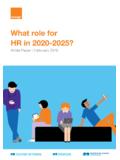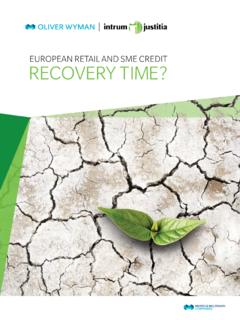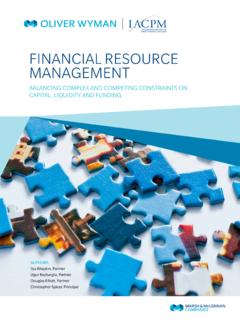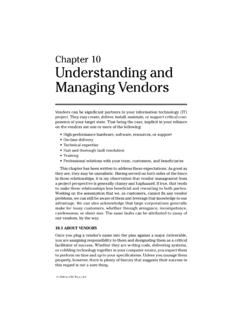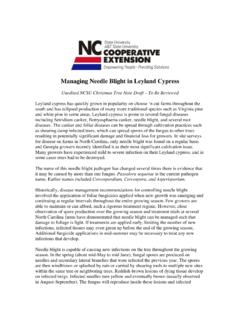Transcription of Managing the Organization Dynamics of Downsizing
1 Executive SummaryWhen managed effectively, Downsizing can yield significant economic and organizational benefits. Reducing people costs has an immediate positive impact on the company s bottom line. Additionally, proponents point to longer term benefits of delayering and reducing administrative overhead, such as faster deci-sion making, greater entrepreneurial behavior, and smoother , most Downsizing initiatives are not managed effective-ly. One study of 288 Downsizing companies indicates that less than half met their cost reduction goals through restructuring. Poorly man-aged Downsizing can also result in severe decrements in employee engagement and morale, a general climate characterized by lack of trust in management and reduced loyalty to the company, and, ulti-mately, decreased company leadership faces unique challenges during Downsizing . Effective management requires that leaders address the needs of those employees who are asked to leave, as well as those who stay behind.
2 Surviving a layoff can be an energizing and motivating experience, or it can lead to lack of trust and resentment. Survivors concerns include worries about future job security, uncertainty about how to DeltaManaging the Organization Dynamics of DownsizingOliver Wyman Deltasucceed in the new environment, and concern for co-workers asked to leave. During Downsizing , it is critical that managers overcommuni-cate, treat individuals with dignity and respect, and increase manage-rial the layoff, managers must allow employees to play a significant role in shaping the post-layoff environment, clarify the new oppor-tunities and career paths available to survivors, and recognize and reward those survivors who engage in desirable post-layoff behav-iors. Leaders must communicate the relationship between downsiz-ing and corporate strategy so that employees understand how the workforce reduction supports the long-term success of the company.
3 Additionally, it is the leadership s responsibility to ensure that layoffs are carried out in a way that is consistent with the company s values and core beliefs. Downsizing : Promises and Pitfalls Downsizing the planned elimination of positions or jobs is expected to yield rapid economic benefits. People costs often exceed 40 percent of a company s total As a result, cutting costs by cutting people appears to be an effective strategy for increas-ing shareholder return. Additionally, proponents of Downsizing point to organizational benefits such as lessened bureaucracy, faster deci-sion making, smoother communications, streamlined operations, and enhanced effectiveness and 3 However, a 2002 survey by Watson Wyatt of 288 corporations revealed that of the 86 percent of companies that reorganized to cut costs in the last major economic downturn, only 47 percent met their cost reduction goals through their , an analysis of Downsizing at S&P 500 companies between August 2000 and August 2001 indicates that companies that per-formed few or no layoffs performed significantly better than compa-nies with large layoffs.
4 Of the 25 percent of companies that conducted layoffs, those that reduced their workforce by 3 percent or less did not outperform companies with no layoffs, with both groups posting an average of 9 percent share price increases. Furthermore, share prices remained flat in those companies that downsized between 3 and 10 percent, and plummeted 38 percent among companies that reduced their workforces by more than 10 of the root cause of layoffs in these companies indicates that the reason for Downsizing is significant to shareholders. When cost-2 Managing the Organization Dynamics of Downsizingcutting was the reason for layoffs, share prices rose only 2 percent, on average, from the 30 days before the announcement to the 90 days after. In contrast, companies that downsized as part of a strategy to consolidate mergers and leverage synergies enjoyed a 9 percent stock rise in the same timeframe.
5 This is in part due to the fact that many companies will not experience the financial reward of layoffs unless the eliminated jobs are not replaced for six to twelve months, and many companies re-hire the employees they lay off before the benefit can be Impact of Poorly Managed DownsizingAdditionally, Downsizing often falls short because the leadership and management fail to recognize the complexities of Downsizing , anticipate prob-lems, or plan The long-term conse-quences of poorly managed Downsizing can be seen in the following areas: Employee motivation and morale. Studies show that following a Downsizing , surviving employ-ees may become narrow-minded, self-absorbed, and risk-averse. Morale sinks, and productivity may drop. Survivors are often consumed with seeking information regarding their own security and searching for reassurance rather than Operating environment.
6 The general climate of a company after a Downsizing may be character-ized by a lack of trust in management and a belief that employee loyalty and concern for the company are no longer valued. Organizational capabilities. Workforce reductions may result in a loss of expertise and organiza-tional memory, decreased performance stan-dards and insufficient capacity to act. This poses a greater risk for learning organizations, which rely on their human capital and relationships to innovate and Company reputation. The way a company treats its employees greatly affects how it is viewed by the public. Many companies fail to recognize the importance of communications regarding down-sizing to external constituents, including share-holders and Those Who LeaveTo minimize the negative consequences of down-sizing, employers often try to get as close to their Downsizing goals as possible by offering unpaid sabbaticals or sweeteners that encourage early retirement and voluntary severance.
7 If the com-pany can afford to wait, attrition may accomplish much of the remaining reduction, so that only a few actual layoffs are There are times, however, when the need to termi-nate some of the workforce is inescapable. In those cases, employers have a number of levers available to minimize the negative impact on those who must leave: Communicate more to minimize uncertainty. Provide as much information and fair warning as possible. Some companies provide pre-layoff workshops designed to help employees under-stand the why, when, and how of being down-sized. Regular, open, honest communication is critical to foster employee trust that is crucial during Downsizing 11 Conduct Downsizing all at once. If possible, avoid a series of unsettling announcements; before long, they feed the sense of downward momentum and have a corrosive, cumulative effect.
8 Strive for process fairness. Procedures are per-ceived as fair if they are made consistently, without self-interest, on the basis of accurate information, with opportunities to correct and the interests of all concerned parties represented and following moral and ethical Not only is it the right thing to do; a significant busi-3 Oliver Wyman Deltaness case can also be made for process fairness. Research suggests that former employees are significantly less likely to take legal action against the company if they perceive the process to be fair (1 percent) versus unfair (17 percent). Some estimate the expected cost savings of practicing process fairness at $ million for every 100 employees Treat employees with dignity. Allow employees the opportunity to say goodbye. Resist the temptation to suspect or devalue employees who have been cut because of business necessity.
9 Offer resources. Financial education. Outplaced employees are interested in answers to financial questions like, Can my 401(k) come with me? and What are the costs of COBRA? Onsite employee support and counseling. Onsite professional coun-seling on the day of layoff announcements can help affected employees process their immediate reactions and feelings and set them up for longer-term outplacement support. Outplacement Depending on the needs of the employ-ees, this type of resource can emphasize rapid re-employment with effective self-marketing tools and techniques or a process of career evaluation, education, and In addition to one-on-one counseling, outplacement centers can also be a gather-ing place for socializing, networking, and support for groups of affected Retraining. Companies can contribute to outplaced employees education, or in training to enhance their skills and help make them marketable for employment elsewhere.
10 This can be accom-plished through education fairs or tuition Paid insurance benefits. Some companies provide incentive pro-grams such as continuing health and/or life insurance benefits for a specified period of time for employees who voluntarily resign. Create opportunities. Fund entrepreneurial activities. Provide seed funds for employees who start their own the Organization Dynamics of Downsizing Referrals, company-to-company loans of employ-ees, and job fairs. Companies can form allianc-es with their sister companies or other area businesses to help displaced employees find employment and provide Temporary work opportunities. Instead of the outright severing of ties with the Organization , companies may institute a job-share program where two employees share one position, with responsibilities split 50/50. Companies can also retain employees as independent con-tractors to smooth their individual transitions, while allowing the business to retain some continuity of work.





